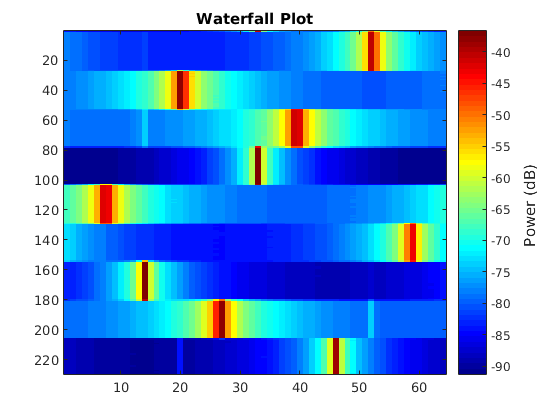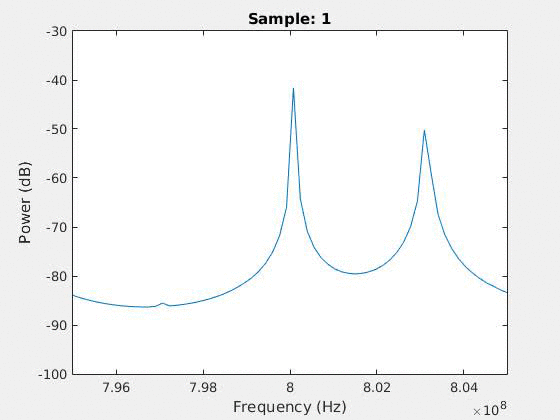| Version 62 (modified by , 10 years ago) ( diff ) |
|---|
SDR in ORBIT: Spectrum Sensing
Table of Contents
- 2015 Winlab Summer Internship
- LTE Unlicensed (LTE-U)
- Introduction
- Objectives
- Theory
- Analyzing Tools
- Experiment 1: Transmit and Receive LTE Signal
- Experiment 2: The Waterfall Plot
- Experiment 3: eNB and UE GUI
- Experiment 4: Varying Bandwidths
- Experiment 5: Working with TDD or FDD
- Experiment 6: TDD with Varying Bandwidths
- Experiment 7: TDD Waterfall Plot
- Poster
- Members
- Materials
- Resources
- LTE Unlicensed (LTE-U)
- Body Sensor Networks
- Dynamic Video Encoding
Introduction
Spectrum sensing is the systematic scanning of the available radio frequency spectrum for areas of high usage. Our project involves the use of Universal Software Radio Peripherals (USRPs) in ORBIT to detect which frequencies are in use at any given time. Using GNURadio and MATLAB/Octave for signal processing, we aim to detect with optimal speed and efficiency the frequency of any signal transmitted from an unknown source. Accomplishing this goal will help to identify available bands in the frequency spectrum, giving opportunities for more efficient usage.
Team
 |
 |
|
| Christina Baaklini Electrical and Computer Engineering Rutgers University |
Michael Collins Electrical and Computer Engineering Rutgers University |
Nicole DiLeo Electrical and Computer Engineering Rutgers University |
Project guided by Wade Trappe, Dola Saha, and Ivan Seskar.
Current Objectives
- Knowledge of basic Digital Signal Processing concepts.
- Knowledge of filter design.
- Utilization of ORBIT.
- Writing/editing scripts.
- Saving from console to local devices.
- Running experiments on the grid.
- Utilization of MATLAB to process signals.
- Fast Fourier Transform (fft).
- Inverse Fast Fourier Transform (ifft).
Weekly Progress
Weeks 1-2 (Presentation)
- Formation of project group.
- Development of project goals.
- Preliminary research on software-defined radio.
Week 3 (Presentation)
- Research on analog-to-digital conversion.
- Familiarization with Fast Fourier Transform (fft) in MATLAB.
- USRP Tutorials using ORBIT.
Week 4 (Presentation)
- Research on filter design.
- Wrote/Modified OEDL scripts. See Experiment 1.
- Wrote a MATLAB script for signal visualization.
Week 5 in progress.
Experiments

| 
|
Signal Transmission and Processing with USRP2 and wiserd
In this experiment we modify the Spectrum sensing with USRP2 and wiserd (OEDL and OML) tutorial.
The tutorial uses two USRPs: one transmitter and one receiver. The transmitter starts at 798 MHz and increases to 802 MHz over a span of 5 seconds. The receiver has a carrier frequency of 800 MHz and bandwidth of 5 MHz.
As our first experiment we modified the tutorial. We increase the sampling rate to 10 MHz, so we can accurately receive frequencies up to 5 MHz greater or lesser than the receiver's carrier frequency. We then randomly select frequencies from 796 to 804 MHz to transmit for one second each.
Using OML, we save the receiver readings to a file for processing in MATLAB/Octave. Using a MATLAB script, we generate a waterfall plot of the data, along with an animated power vs. frequency plot.
Attachments (25)
-
WINLAB Weeks 1-2.pptx
(602.4 KB
) - added by 11 years ago.
Presentation 1
- collins.jpg (106.2 KB ) - added by 11 years ago.
- nicole.PNG (80.3 KB ) - added by 11 years ago.
- christina.jpg (44.6 KB ) - added by 10 years ago.
- Spectrum Sensing Weeks 1-2.pdf (410.0 KB ) - added by 10 years ago.
- Spectrum Sensing Week 3.pdf (364.5 KB ) - added by 10 years ago.
- Spectrum Sensing Week 4.pdf (351.0 KB ) - added by 10 years ago.
- waterfall_plot.fig (92.6 KB ) - added by 10 years ago.
- exp1_2.gif (280.7 KB ) - added by 10 years ago.
- exp1_1.2.png (5.4 KB ) - added by 10 years ago.
- exp1_1.png (19.2 KB ) - added by 10 years ago.
- exp1_2.2.gif (824.6 KB ) - added by 10 years ago.
- exp1_3.png (191.1 KB ) - added by 10 years ago.
- Spectrum Sensing Week 5.pdf (467.2 KB ) - added by 10 years ago.
- grid_exp1.png (7.3 KB ) - added by 10 years ago.
- Spectrum Sensing Week 6.pdf (269.1 KB ) - added by 10 years ago.
- Spectrum Sensing Week 7.pdf (922.8 KB ) - added by 10 years ago.
- nick.png (520.8 KB ) - added by 10 years ago.
- exp2_1.png (120.6 KB ) - added by 10 years ago.
- exp2_2.png (25.3 KB ) - added by 10 years ago.
- Spectrum Sensing Presentation to NYIT.pdf (3.0 MB ) - added by 10 years ago.
- Spectrum Sensing Week 9.pdf (320.8 KB ) - added by 10 years ago.
- Spectrum Sensing Week 10.pdf (406.3 KB ) - added by 10 years ago.
- Spectrum Sensing Week 11.pdf (250.6 KB ) - added by 10 years ago.
- Spectrum Sensing Week 12.pdf (667.8 KB ) - added by 10 years ago.
